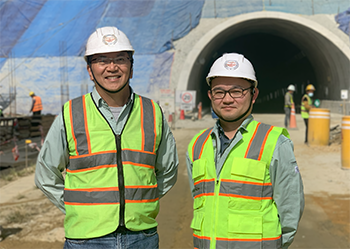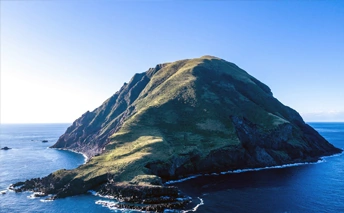A Lifeline Connecting Us in Times of Disaster: The Nagdhunga Tunnel, Nepal
Release:
Update:
NEW
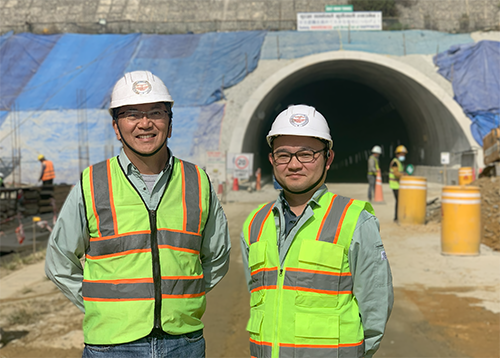
Disaster-resistant roadway tunnel greatly reduces transit time after opening
Nepal is located between the two great powers, China to the north and India to the south. About 80% of the country consists of mountainous terrain formed by the Himalayan orogenic belt. The flow of people and goods between the capital Kathmandu, which is surrounded by steep mountains, and other major cities is limited. Because of this, it is difficult for major industries to develop. Agriculture, forestry, and tourism, which take advantage of the mountains, are the mainstays of the economy. In Nepal, the demand for safe and disaster-resistant roads that contribute to smooth transportation, logistics, and economic development, is extremely high. However, limited financial resources and harsh terrain conditions have prevented progress in the development of road networks, and road development methods have been limited.
Nippon Koei has contributed to Nepal’s development through a wide range of projects in a variety of fields, beginning with water resource development and hydropower generation using Nepal’s mountainous terrain, and continuing with power transmission and distribution network development, agricultural and irrigation development, and work in the transportation sector, including the Sindhuli Road. The artery reaching India has been the lifeline for Nepal. Sindhuli Road, a route leading to India from the east side of Kathmandu, was constructed through Japanese grant aid (we were continuously involved as a consultant from 1986 to 2015). In contrast, the Tribhuvan Highway, an old western route to India, has numerous traffic difficulties due to a combination of steep grades, hairpin curves, frequent slope collapses, and weak pavement conditions. The Nagdhunga Tunnel discussed in this article is a road tunnel under construction on the Nagdhunga Pass, one of its most difficult sections. The construction of this tunnel is expected to make the road more resilient to disasters. The normal transit time of approximately 30 minutes, or in the case of traffic congestion, more than an hour at times, is expected to be shortened to 6 to 7 minutes with the opening of this tunnel. Tunnels are also considered safe structures because they are resistant to landslides and earthquakes. The opening of this tunnel will enhance convenience and safety for the residents in the region.


Support for long-lasting operation and tunnel maintenance
Nippon Koei JV has been providing consulting services for detailed design, bidding support, construction supervision, and Operation & Maintenance (O&M) capability enhancement regarding the Nagdhunga Tunnel construction project, an ODA loan project, since March 2017. The two-way-traffic tunnel of 2,688 m long is paralleled by an emergency evacuation tunnel (a small cross-section tunnel). Tunnels require extremely advanced and complex techniques and experience, as the digging method must be adjusted to the hardness of the ground (the rock and soil) and the location where the tunnel is to be dug. Japan, as a major tunneling country, possesses advanced tunneling technology. In view of Nepal’s complex topography and geological conditions, the project was planned and designed with reference to advanced Japanese design standards. As of December 2024, construction supervision and O&M capability enhancement are underway.
Construction has been progressing as follows: the breakthrough of the evacuation tunnel occurred in August 2023, the breakthrough of the main shaft occurred in April 2024, and the concrete lining was completed in November 2024. The remaining work in the tunnel will consist of concrete paving and equipment installation, with construction scheduled to be completed and the tunnel opened to public use in October 2025.
While the Nagdhunga Tunnel is being constructed as the country’s first full-scale tunnel equipped with emergency facilities and ventilation systems, the Nepalese government has had no O&M experience with roadway tunnels. Under the Japanese ODA loan scheme, the consultants are required to extend services to assist the government in enhancing its O&M capabilities to establish a system for properly operating and maintaining the tunnel facilities well into the future. In addition, providing support for O&M expertise is also included as a consultant's service under the loan scheme.
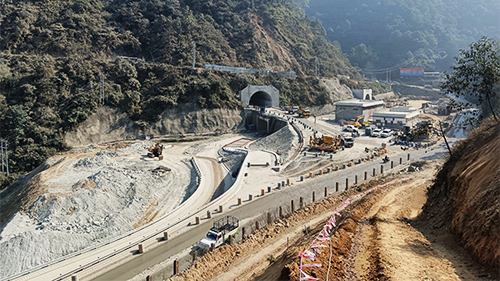
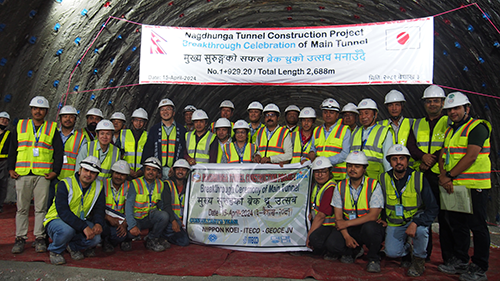
Functioning as a lifeline during an emergency
Nepal is known for its heavy rainfall from July to September each year, and landslides are frequent. 2024 was also a very wet year, with numerous reports of damage coming in almost weekly. In addition to that, an early October monsoon caused torrential rains that lasted for about two days. There were landslides caused by collapsing slopes in many locations around the site, resulting in a tragic situation that included buried buses and numerous casualties. Existing roads west of the tunnel were also cut off, stranding many vehicles entering Kathmandu and hindering the passage of emergency vehicles.
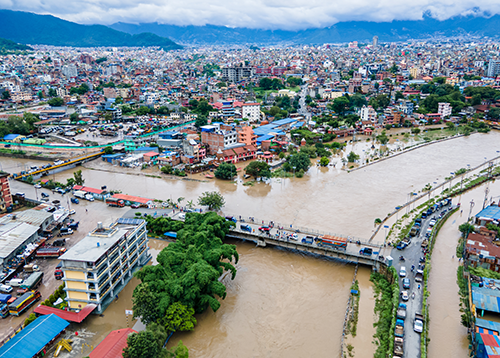
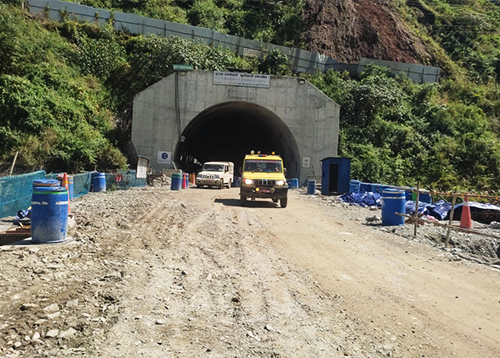
At the request of the local police, the Japanese side and the Department of Roads of the Nepali government cooperated to use the Nagdhunga Tunnel, which had been driven through but not yet paved, on an emergency basis to temporarily allow buses and emergency vehicles to pass through, contributing to the relief of over 4,000 residents and others. The event was also reported on by a number of domestic media outlets.
VOICE
As Nepal’s first roadway tunnel, this project has been challenging at all stages, including detailed design, bidding support, construction supervision, and O&M capability enhancement.
While we were supervising construction, it was found that the tunnel excavation surface curved due to the significant ground pressure caused by the formation of the Himalayas, and excavation continued with large deformations. Shigeaki Tanaka, General Manager of the International Road and Bridge Department, led a team of specialists from the JV partner companies and about 30 local engineers. The entire team worked hard to supervise the on-site construction.
In terms of enhancing O&M capabilities, we are also working diligently to support O&M contractor procurement, prepare manuals, and coordinate with local agencies to ensure safe tunnel traffic operation.
Less than a year remains before construction is completed. The on-site construction supervision office and the O&M capability enhancement team will continue working together to ensure the safe and secure opening of the roadway tunnel as part of Japan’s assistance to Nepal.
General Manager of the Nagdhunga Tunnel
Construction Planning Project Office
Right: Takuya Kuramochi
O&M Capability Enhancement Leader
